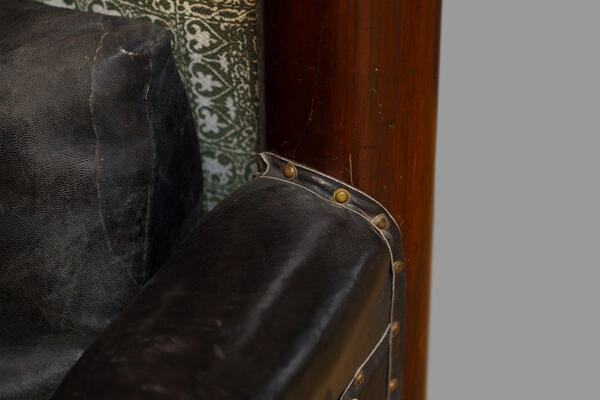The armchair, which is part of the museum collection, belonged to Nikolay Alexeyevich Nekrasov.
According to the poet’s nieces and literary sources, during Nekrasov’s lifetime the armchair stood in front of the fireplace of the East Wing of the Karabikha estate.
This exhibit belongs to the so-called “overstuffing” furniture, which has a wooden base completely covered with upholstery.
The backrest has a rectangular shape and is fitted with a removable cushion. A folding board is attached on hinges to the back of the backrest. The backrest, seat, armrests and cushion are upholstered in black synthetic leather on the front side.
The front side of the backrest and the back side of the cushion are upholstered in a fabric with a white floral pattern on a dark green background.
When the upholstery was restored, it was discovered that the armchair consisted of four separate parts: the backrest with posts, the seat and two side parts with armrests. The original upholstery was of bright red woolen fabric. Later, the armchair was reupholstered in green morocco, that is, thin and soft goat or sheep leather. The third and fourth upholsteries were made of dark green oilcloth.
The wooden parts are joined together with wooden spikes and iron bolts. Currently, the backrest, seat and armrests are upholstered in black artificial leather.
The armchairs, which had similar design features, were called “crapaud armchairs”, from the French word meaning “toad”. Such furniture provided a comfortable place to sit, read or write semi-reclined. Crapaud armchairs were especially in demand among the artistic intelligentsia.
Usually, these interior items had additional hinged pedestals on the sides and on the back. In this exhibit, only the shelf has been preserved. A pencil and paper could be placed on it. There was sometimes a pull-out bottom drawer with a folding desk, which is missing in this piece.
In 1919, when Karabikha was nationalized, the
armchair was transferred to the Yaroslavl Museum of Local Lore, and in 1947, it
was returned to the estate.





